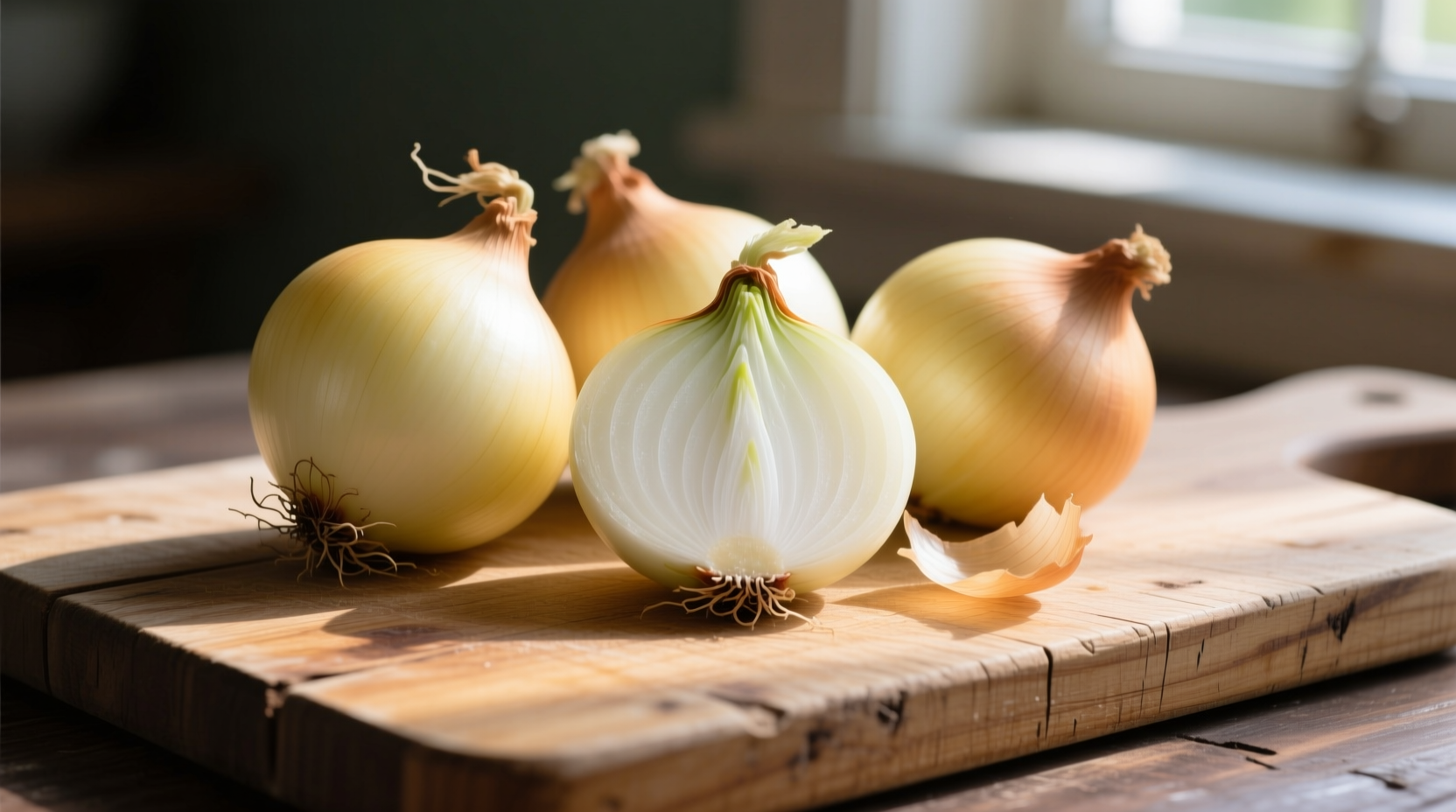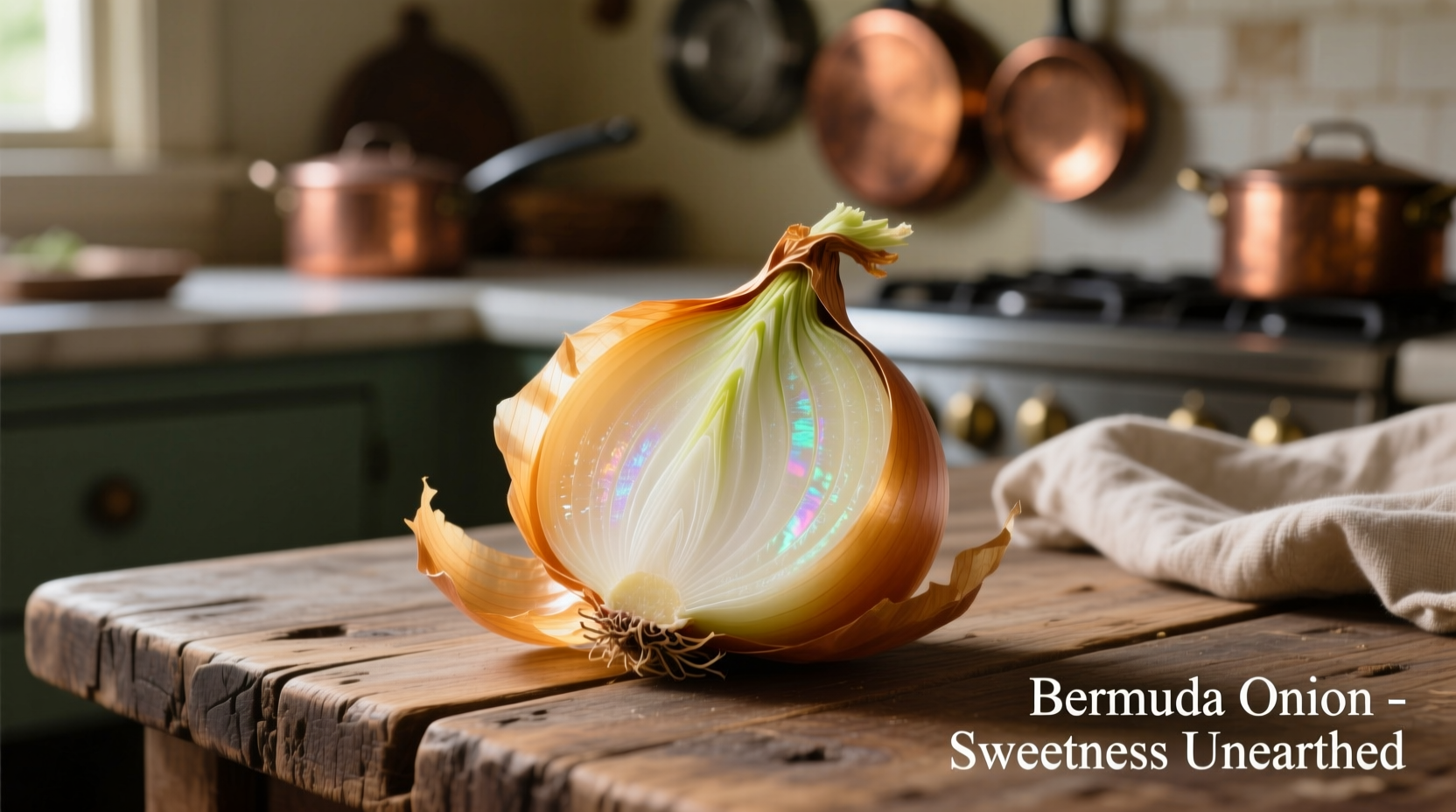Ever bitten into a sandwich only to be overwhelmed by the sharp bite of a regular onion? That's where Bermuda onions shine. These culinary gems offer the perfect balance of sweetness and mildness that transforms ordinary dishes into extraordinary creations without the harsh aftertaste. Whether you're crafting a summer salad or topping a gourmet burger, understanding this versatile ingredient can elevate your cooking from good to exceptional.
What Exactly Are Bermuda Onions?
Bermuda onions (Allium cepa var. aggregatum) represent one of the original sweet onion varieties cultivated in the Western hemisphere. Despite their name, they didn't originate in Bermuda but earned their designation through historical export patterns from the island. These onions feature a distinctive flattened shape with pale yellow or white skin and crisp, juicy white flesh that delivers a delicate sweetness without the intense pungency of storage onions.
Unlike their stronger cousins, Bermuda onions contain lower levels of sulfur compounds, which translates to a milder flavor profile and reduced eye irritation during preparation. Their high water content (approximately 89%) creates that signature crisp texture that holds up beautifully in fresh applications. When selecting Bermuda onions, look for firm bulbs with dry, papery skins and no soft spots - these characteristics indicate peak freshness and optimal flavor.
Visual Identification Guide
Recognizing a genuine Bermuda onion requires attention to specific physical characteristics. These onions typically measure 2-3 inches in diameter with a noticeably flattened shape that distinguishes them from the more rounded storage onions. The skin ranges from pale yellow to white, often with a slightly translucent quality when held to light. When cut open, the layers appear more widely spaced than those of regular onions, creating that desirable crisp texture.
One practical identification tip: Bermuda onions often have a slightly concave bottom rather than the pointed root typical of other varieties. Their outer skin peels away easily in large, continuous sheets - a characteristic that makes preparation quick and efficient. When shopping, avoid bulbs with green sprouts or dark blemishes, as these indicate age and potential flavor degradation.

Flavor Profile and Culinary Applications
The magic of Bermuda onions lies in their balanced flavor profile - sweet enough to eat raw without causing discomfort, yet substantial enough to provide aromatic depth to cooked dishes. Their sugar content typically ranges from 4-6%, creating that pleasant sweetness without overwhelming other ingredients. Professional chefs particularly value Bermuda onions for their ability to maintain texture when lightly cooked, making them ideal for quick sautés and caramelization without turning mushy.
For optimal flavor extraction, try these techniques:
- Thin slicing - Use a mandoline for paper-thin slices that distribute evenly in salads
- Quick pickling - Soak slices in vinegar solution for 15 minutes to enhance sweetness
- Cold water bath - Reduce sharpness further by soaking cut onions in ice water for 10 minutes
- Layered cooking - Add during the final stages of cooking to preserve texture and flavor
These methods maximize the onion's natural qualities while minimizing any potential bitterness. The culinary versatility of Bermuda onions extends from raw applications like pico de gallo and onion rings to cooked preparations including quiches, stir-fries, and roasted vegetable medleys.
How Bermuda Onions Compare to Other Varieties
| Onion Type | Flavor Profile | Best Culinary Uses | Storage Life |
|---|---|---|---|
| Bermuda | Mild, sweet, crisp | Raw applications, quick cooking | 2-3 weeks refrigerated |
| Vidalia | Very sweet, delicate | Raw consumption, light cooking | 3-4 weeks refrigerated |
| Yellow Storage | Strong, pungent | Long cooking, soups, stews | 2-3 months cool storage |
| Red | Medium heat, slightly sweet | Salads, salsas, pickling | 3-4 weeks refrigerated |
This comparison reveals why Bermuda onions excel in applications requiring fresh onion flavor without overwhelming heat. According to agricultural research from Texas A&M AgriLife Extension, Bermuda onions contain approximately 30% less pyruvic acid (the compound responsible for onion pungency) than standard yellow onions, explaining their milder profile. Their unique growing conditions in specific coastal regions contribute to this distinctive chemical composition.
When to Choose Bermuda Onions (and When Not To)
Understanding the context boundaries for Bermuda onions ensures optimal culinary results. These onions shine in applications where fresh onion flavor enhances rather than dominates:
- Ideal for: Summer salads, fresh salsas, sandwich toppings, quick-pickled garnishes, light stir-fries, and any dish where raw onion flavor should complement rather than overpower
- Less suitable for: Long-simmered soups, stews requiring deep caramelization, or applications needing strong onion flavor that holds up through extended cooking
The University of California Cooperative Extension notes that Bermuda onions' high water content makes them less suitable for dehydration or long-term storage applications compared to storage onion varieties. Their delicate flavor compounds break down more quickly when exposed to heat, which explains why they're best added during the final minutes of cooking rather than at the beginning.
Sourcing and Seasonality
Bermuda onions enjoy a relatively short seasonal window, typically appearing in markets from late spring through early summer. Their peak season runs from May to July, when you'll find the sweetest, crispest specimens. While historically associated with Bermuda, today's primary growing regions include specific coastal areas of Texas, California, and Georgia where the sandy soil and maritime climate create ideal growing conditions.
When shopping, look for "Bermuda" specifically labeled - many supermarkets mistakenly label other sweet onions as Bermuda due to consumer recognition. True Bermuda onions maintain that distinctive flattened shape and pale color. Farmers' markets during peak season offer the best chance to find authentic specimens, as commercial distribution often favors the more uniform Vidalia and Walla Walla varieties.
Storage and Preparation Tips
Proper storage significantly extends the shelf life of Bermuda onions. Unlike storage onions, they require refrigeration to maintain quality. Store them in the crisper drawer of your refrigerator in a mesh bag or perforated container to allow airflow. Avoid storing near apples or pears, as ethylene gas from these fruits accelerates spoilage.
For meal preparation, follow these professional techniques:
- Chill onions for 30 minutes before cutting to reduce tearing
- Use a sharp knife to minimize cell damage and preserve crispness
- Cut against the grain (perpendicular to growth rings) for maximum crispness in salads
- Soak cut onions in ice water for 10 minutes to enhance sweetness and reduce sharpness
When substituting in recipes, remember that 1 cup of chopped Bermuda onion equals approximately 150g by weight. Their mild flavor means you can often use 25% more than you would with stronger onion varieties without overwhelming the dish.
Nutritional Benefits
Beyond their culinary appeal, Bermuda onions offer notable nutritional advantages. A 100g serving provides 42 calories, 1g of protein, and 10g of carbohydrates, with 2.4g of dietary fiber. They're an excellent source of vitamin C (15% of daily value), vitamin B6, and manganese. The flavonoid quercetin, particularly concentrated in the outer layers, offers antioxidant benefits that increase when onions are cut and allowed to sit for 10 minutes before consumption.
Research published in the Journal of Agricultural and Food Chemistry confirms that the mild flavor of Bermuda onions correlates with higher levels of certain beneficial compounds compared to stronger onion varieties. Their lower sulfur content doesn't mean fewer health benefits - rather, it indicates a different phytochemical profile that may be better tolerated by individuals sensitive to stronger onions.
Frequently Asked Questions
Can I substitute Bermuda onions for red onions in salads?
Yes, Bermuda onions make an excellent substitute for red onions in salads, offering a milder, sweeter flavor without the strong bite. Use a 1:1 ratio, but you may want to increase the quantity slightly since Bermuda onions have less intensity. Their pale color also creates a more subtle visual presence in mixed green salads.
How long do Bermuda onions stay fresh?
Properly stored in the refrigerator's crisper drawer, Bermuda onions maintain peak quality for 2-3 weeks. Signs of spoilage include soft spots, dark blemishes, or a slimy texture. Unlike storage onions, they shouldn't be kept at room temperature for extended periods, as their high water content causes them to deteriorate more quickly.
What's the best way to reduce tears when cutting Bermuda onions?
Chill Bermuda onions in the refrigerator for 30 minutes before cutting, as cold temperatures slow the release of tear-inducing compounds. Use a sharp knife to minimize cell damage, and cut near running water or under a vent to disperse the volatile compounds. Their lower sulfur content already makes them less tear-inducing than yellow storage onions.
Are Bermuda onions the same as sweet onions?
Bermuda onions are a specific type of sweet onion, but not all sweet onions are Bermuda onions. While Vidalia, Walla Walla, and Maui onions are also sweet varieties, Bermuda onions have a distinctive flattened shape and pale color. They were among the first sweet onion varieties developed and have a slightly different flavor profile with more pronounced crispness and less honey-like sweetness than some modern varieties.











 浙公网安备
33010002000092号
浙公网安备
33010002000092号 浙B2-20120091-4
浙B2-20120091-4